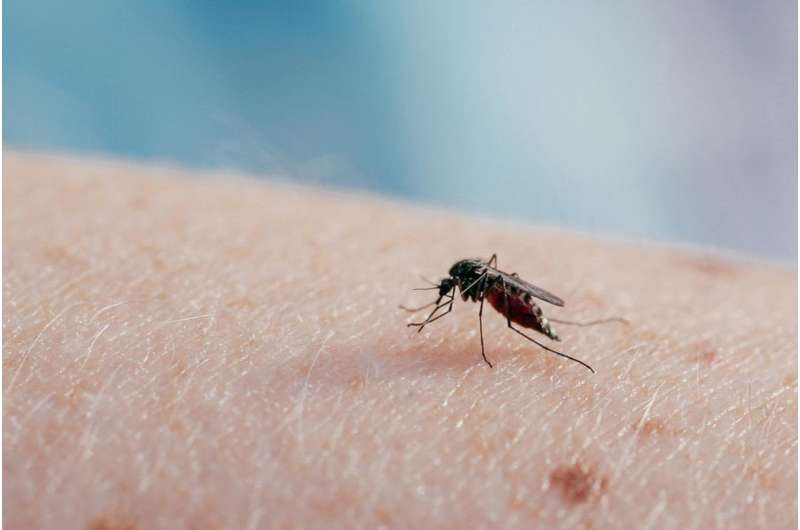The fate of Arctic mosquitoes depends on habitat and access to blood meals

The future of Arctic mosquitoes (Aedes nigripes) in western Greenland depends on aquatic habitat and access to blood meals, according to a Dartmouth study. The study found that female mosquitoes carrying eggs were most abundant near ponds, especially in areas frequented by animals such as caribou, birds and the Arctic hare. Published in Ecosphere, the findings provide new insight into mosquito population dynamics. The rapid rate of environmental changes in the Arctic are impacting aquatic habitats and wildlife that mosquitoes depend on for blood meals. Mosquitoes also serve as food for a variety of species and pollinators for tundra plants in addition to their more notorious role as pests to humans and wildlife.
The life cycle of Arctic mosquitoes depends in part on shallow temporary ponds formed by melting snow in the tundra, where larvae emerge from mosquito eggs. After emergence, female Arctic mosquitoes mate and then seek a blood meal before laying their eggs on the dry edges of ponds. Once the eggs are exposed to water in the following spring, the mosquito eggs will hatch. For Arctic mosquitoes to pass on their genes to the next generation, they typically require a blood meal. The blood meal provides a source of protein only found in animals, which cannot be obtained from feeding on flower nectar.
To better understand Arctic mosquito population dynamics, the researchers collected over 3,500 mosquitoes at five sites (four snow melt pond areas and one site in town) on three different sampling occasions in Kangerlussuaq, Greenland. The samples were frozen and counted. The mosquitoes were later dissected in the lab to determine if a female was gravid, that is, carrying eggs; if so, the number of eggs in the mosquito's abdomen was then counted. Of those that had eggs, an average female mosquito contained about 60 eggs.
Over 40 percent of the mosquitoes were collected at one of the pond sites, where aquatic habitat was abundant and the researchers would frequently observe wildlife— caribou, muskox, hare, and waterfowl— utilizing plant and water resources. This was also where they found the highest numbers of mosquitoes with eggs— 43 percent, as compared with 17 percent in the overall study.
The site in the town of Kangerlussuaq had high densities of mosquitoes but while there were plenty of blood meals to be had with human hosts around, female gravid rates were low. This may be due in part to humans' ability to take measures to prevent mosquitoes from biting them, such as by using chemical repellants and swatting, a defense mechanism that other animals are unable to use.
The abundance of gravid females was also low at the site nearest the Greenland ice sheet (about one mile), where colder water slowed the development rates of immature mosquitoes developing in ponds and the cold, windy conditions may have restricted the ability of adults to fly in search of blood meals.
The research team developed a model to estimate mosquito population change based on immature mosquitoes (larvae and pupae) surviving to the adult stage and their probability of reproduction. At each site except near the ice sheet, mosquito populations could exceed the replacement rate, whereby, an average female mosquito was projected to produce at least one female offspring for the next year.
"Arctic mosquitoes are notoriously abundant. Our research attempts to understand Arctic mosquitoes' population size, which like other species in the region, is likely to be affected by the rapid environmental changes underway in the Arctic," said Lauren Culler, the lead author and a research assistant professor of environmental studies at Dartmouth.
The study builds on earlier research led by Culler, which demonstrated that with climate change, Arctic mosquitoes are growing faster and emerging earlier, making them more likely to survive to the adult reproductive stage. But an earlier emergence may reduce successful reproduction if they emerge before the caribou have given birth to calves, an event which is expected to increase the availability of blood meals. The new findings indicate that surviving to the adult stage and successfully reproducing are equally important in determining the outcome for mosquitoes.
As rapid Arctic change continues to unfold, the researchers expect significant impacts on aquatic habitat and blood meal availability due to changes in hydrology and wildlife abundance. For example, caribou typically have their calves at the beginning of June based on changes in daylight, which does not change with climate warming even though mosquitoes are extremely sensitive to temperature for their development, behavior and survival. Snow melt ponds are also in a state of flux due to warming temperatures, permafrost melt and variability in Arctic precipitation. Fortunately, at least for now, there are no diseases known to be carried by mosquitoes in Greenland or elsewhere in the Arctic.
More information: Spatial heterogeneity in the abundance and fecundity of Arctic mosquitoes, Lauren E. Culler Matthew P. Ayres Ross A. Virginia Ecosphere (2018). DOI: 10.1002/ecs2.2345




















